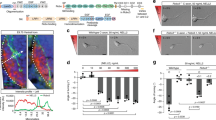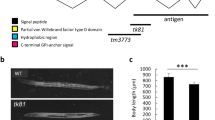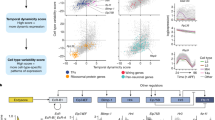Abstract
Netrin is a secreted protein that can act as a chemotropic axon guidance cue1,2. Two classes of Netrin receptor, DCC3,4,5 and UNC-5 (refs 6,7,8,9), are required for axon guidance3,4,6,7,8,9,10,11 and are thought to mediate Netrin signals in growth cones through their cytoplasmic domains12,13. However, in the guidance of Drosophila photoreceptor axons, the DCC orthologue Frazzled3 is required not in the photoreceptor neurons but instead in their targets, indicating that Frazzled also has a non-cell-autonomous function14. Here we show that Frazzled can capture Netrin and ‘present’ it for recognition by other receptors. Moreover, Frazzled itself is actively localized within the axon through its cytoplasmic domain, and thereby rearranges Netrin protein into a spatial pattern completely different from the pattern of Netrin gene expression. Frazzled-dependent guidance of one pioneer neuron in the central nervous system can be accounted for solely on the basis of this ability of Frazzled to control Netrin distribution, and not by Frazzled signalling. We propose a model of patterning mechanism in which a receptor rearranges secreted ligand molecules, thereby creating positional information for other receptors.
This is a preview of subscription content, access via your institution
Access options
Subscribe to this journal
Receive 51 print issues and online access
$199.00 per year
only $3.90 per issue
Buy this article
- Purchase on Springer Link
- Instant access to full article PDF
Prices may be subject to local taxes which are calculated during checkout




Similar content being viewed by others
References
Serafini, T. et al. The netrins define a family of axon outgrowth-promoting proteins homologous to C. elegans UNC-6. Cell 78, 409–424 (1994).
de la Torre, J. R. et al. Turning of retinal growth cones in a netrin-1 gradient mediated by the netrin receptor DCC. Neuron 6, 1211 –1224 (1997).
Kolodziej, P. A. et al. frazzled encodes a Drosophila member of the DCC immunoglobulin subfamily and is required for CNS and motor axon guidance. Cell 87, 197–204 (1996).
Chan, S. S. et al. UNC-40, a C. elegans homolog of DCC (Deleted in Colorectal Cancer), is required in motile cells responding to UNC-6 netrin cues. Cell 87, 187–195 ( 1996).
Keino-Masu, K. et al. Deleted in Colorectal Cancer (DCC) encodes a netrin receptor. Cell 87, 175–185 (1996).
Leung-Hagesteijn, C. et al. UNC-5, a transmembrane protein with immunoglobulin and thrombospondin type 1 domains, guides cell and pioneer axon migrations in C. elegans. Cell 71, 289–299 (1992).
Hamelin, M., Zhou, Y., Su, M. W., Scott, I. M. & Culotti, J. G. Expression of the UNC-5 guidance receptor in the touch neurons of C. elegans steers their axons dorsally. Nature 364, 327–330 ( 1993).
Ackerman, S. L. et al. The mouse rostral cerebellar malformation gene encodes an UNC-5-like protein. Nature 386, 838– 842 (1997).
Leonardo, E. D. et al. Vertebrate homologues of C. elegans UNC-5 are candidate netrin receptors. Nature 386, 833– 838 (1997).
Fazeli, A. et al. Phenotype of mice lacking functional Deleted in colorectal cancer (Dcc) gene. Nature 386, 796– 804 (1997).
Przyborski, S. A., Knowles, B. B. & Ackerman, S. L. Embryonic phenotype of Unc5h3 mutant mice suggests chemorepulsion during the formation of the rostral cerebellar boundary. Development 125, 41–50 ( 1998).
Hong, K. et al. A ligand-gated association between cytoplasmic domains of UNC5 and DCC family receptors converts netrin-induced growth cone attraction to repulsion. Cell 97, 927– 941 (1999).
Bashaw, G. J. & Goodman, C. S. Chimeric axon guidance receptors: the cytoplasmic domains of slit and netrin receptors specify attraction versus repulsion. Cell 97, 917– 926 (1999).
Gong, Q., Rangarajan R., Seeger, M. & Gaul, U. The Netrin receptor Frazzled is required in the target for establishment of retinal projections in the Drosophila visual system. Development 126, 1451–1456 (1999).
Serafini, T. et al. Netrin-1 is required for commissural axon guidance in the developing vertebrate nervous system. Cell 87, 1001–1014 (1996).
Kennedy, T. E., Serafini, T., de la Torre, J. R. & Tessier-Lavigne, M. Netrins are diffusible chemotropic factors for commissural axons in the embryonic spinal cord. Cell 78, 425– 435 (1994).
Mitchell, K. J. et al. Genetic analysis of Netrin genes in Drosophila: Netrins guide CNS commissural axons and peripheral motor axons. Neuron 17, 203–215 ( 1996).
Harris, R., Sabatelli, L. M., & Seeger, M. A. Guidance cues at the Drosophila CNS midline: identification and characterization of two Drosophila Netrin/UNC-6 homologs. Neuron 17, 217– 228 (1996).
Hedgecock, E. M., Culotti, J. G. & Hall, D. H. The unc-5, unc-6, and unc-40 genes guide circumferential migrations of pioneer axons and mesodermal cells on the epidermis in C. elegans. Neuron 4, 61– 85 (1990).
Wadsworth, W. G., Bhatt, H. & Hedgecock, E. M. Neuroglia and pioneer neurons express UNC-6 to provide global and local netrin cues for guiding migrations in C. elegans. Neuron 16, 35–46 (1996).
Ishii, N., Wadsworth, W. G., Stern, B. D., Culotti, J. G. & Hedgecock, E. M. UNC-6, a laminin-related protein, guides cell and pioneer axon migrations in C. elegans. Neuron 9, 873–881 ( 1992).
Colamarino, S. A. & Tessier-Lavigne, M. The axonal chemoattractant netrin-1 is also a chemorepellent for trochlear motor axons. Cell 81, 621–629 (1995).
Brose, K. et al. Slit proteins bind Robo receptors and have an evolutionarily conserved role in repulsive axon guidance. Cell 96, 795–806 (1999).
Jacobs, J. R. & Goodman, C. S. Embryonic development of axon pathways in the Drosophila CNS. II. Behavior of pioneer growth cones. J. Neurosci. 9, 2412–2422 (1989).
Hidalgo, A. & Brand, A. H. Targeted neuronal ablation: the role of pioneer neurons in guidance and fasciculation in the CNS of Drosophila . Development 124, 3253– 3262 (1997).
Ramírez-Weber, F. A. & Kornberg, T. B. Cytonemes: cellular processes that project to the principal signaling center in Drosophila imaginal discs. Cell 97, 599– 607 (1999).
Winberg, M. L., Mitchell, K. J. & Goodman, C. S. Genetic analysis of the mechanisms controlling target selection: complementary and combinatorial functions of netrins, semaphorins, and IgCAMs. Cell 93, 581– 591 (1998).
Brand, A. H. & Perrimon, N. Targeted gene expression as a means of altering cell fates and generating dominant phenotypes. Development 118, 401–415 ( 1993).
Ashburner, M. Drosophila, a Laboratory Manual. (CSHL, Cold Spring Harbor, 1989).
Fujita, S. C., Zipursky, S. L., Benzer, S., Ferrus, A. & Shotwell, S. L. Monoclonal antibodies against the Drosophila nervous system. Proc. Natl Acad. Sci. USA 79, 7929–7933 ( 1982).
Acknowledgements
We thank A. Chiba, C. S. Goodman, A. Hidalgo, P. Kolodziej, M. Seeger and G. Technau for fly strains; P. Kolodziej and M. Seeger for DNA clones and antibodies; T. Hosoya, Y. Umesono, M. Okabe and all members of the Hotta laboratory for helpful discussions; and Y. Fujioka, M. Seki, M. Sakai and C. Asaka for technical assistance. This work was funded by CREST (Y. Hotta and Y. Hiromi), the Ministry of Education, Science, Sports, and Culture of Japan, and Research for the Future Program of JSPS (Y. Hiromi) and NIH (E.G.).
Author information
Authors and Affiliations
Corresponding author
Rights and permissions
About this article
Cite this article
Hiramoto, M., Hiromi, Y., Giniger, E. et al. The Drosophila Netrin receptor Frazzled guides axons by controlling Netrin distribution. Nature 406, 886–889 (2000). https://doi.org/10.1038/35022571
Received:
Accepted:
Issue Date:
DOI: https://doi.org/10.1038/35022571
This article is cited by
-
RIP at the Synapse and the Role of Intracellular Domains in Neurons
NeuroMolecular Medicine (2020)
-
Drosophila Netrin-B controls mushroom body axon extension and regulates courtship-associated learning and memory of a Drosophila fragile X syndrome model
Molecular Brain (2019)
-
Commissural axon guidance in the developing spinal cord: from Cajal to the present day
Neural Development (2019)
-
Floor-plate-derived netrin-1 is dispensable for commissural axon guidance
Nature (2017)
-
Non cell-autonomous role of DCC in the guidance of the corticospinal tract at the midline
Scientific Reports (2017)
Comments
By submitting a comment you agree to abide by our Terms and Community Guidelines. If you find something abusive or that does not comply with our terms or guidelines please flag it as inappropriate.



